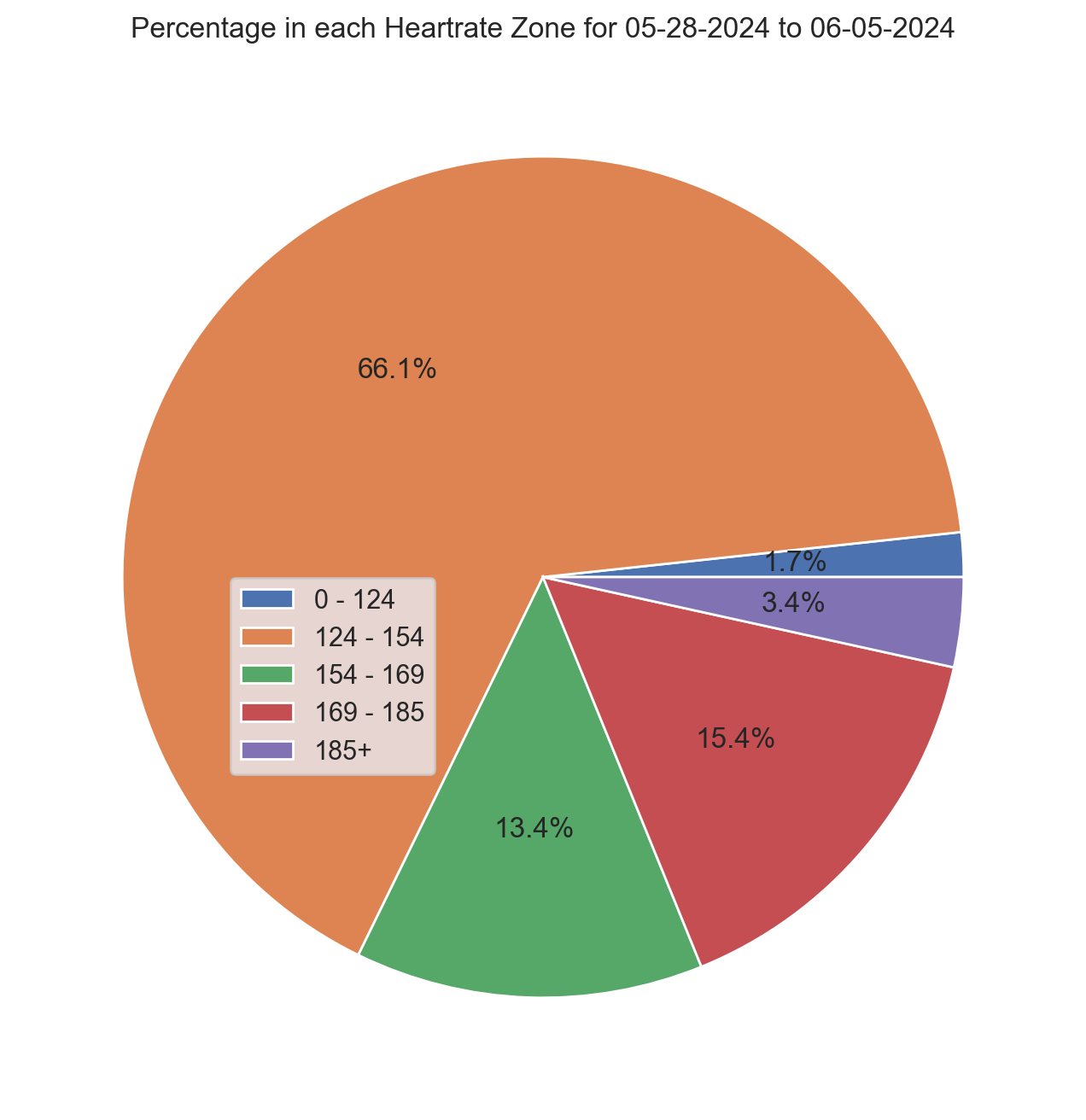Strava natively tracks the time a user spends in each pace and heartrate zone for each activity they upload. This program takes all a user's activities in a provided date range and aggregates the time spent in those pace and heartrate zones during that range.
The outputs are two pie charts (of which there are examples of below) that visualize the amount of time in percentages that was spent in each zone during the date range.
This improves upon Strava's native visualization because they do not (yet!) support tracking and visualizing zones over a period of time. This missing feature undermines the greatest benefits of zone training by making it difficult to track your level of effort over time, i.e., there's no way to see if you've followed an 80-20 split for example if that's your goal.
- Strava's API has the following rate limits (as of 06/04/2024):
- Overall Rate Limits: 200 requests every 15 minutes, 2,000 daily
- Read Rate Limits: 100 requests every 15 minutes, 1,000 daily
- You can check your usage stats in your API Application dashboard.
- With those rate limits in mind, you'll want to be mindful of the date range you set for your activities. You could easily run into the rate limit because this program makes an API call for each activity. My suggested usage of this tool is to see how you're trending weekly or monthly.
- If you've modified your zones in Strava during the requested date range, your pie charts will reflect your new and previous zones. To get cleaner charts, request a date range with consistent zones.
- When prompted for your date ranges in the terminal, it's important to enter them as
MM-DD-YYYYas requested. They will not be converted to epoch timestamps properly if entered otherwise.- The
beforeparameter is NOT inclusive. Theafterparameter IS inclusive.
- The
In order to run this program, you'll need:
- A Strava account.
- At least one activity recorded on that Strava account and one saved piece of gear associated with that activity.
- A personal API application on that Strava account.
- and the corresponding
client_id,client_secretandrefresh_tokenfor that API application.
- and the corresponding
Use your Python IDE of choice to run this program. The requirements.txt file contains the list of dependencies. If running from the terminal, the following commands should work when run from the root directory. You will receive a table as output and the charts will be saved in the /imgs directory:
python -m pip install -r requirements.txt
python main.py
Example output:
score type resource_state sensor_based id zones_sum > 10:31 10:31-09:03 09:03-08:08 08:08-07:37 07:37-07:09 < 07:09
0 3 pace 3 1 11559587973 7388 5850 221 910 277 130 0
1 7 pace 3 1 11536284589 2449 259 809 399 492 309 181
2 3 pace 3 1 11528337526 3082 2962 120 0 0 0 0
3 3 pace 3 1 11520275269 3028 2729 267 32 0 0 0
Total NaN NaN NaN NaN NaN 15947 11800 1417 1341 769 439 181
score type resource_state sensor_based points custom_zones id zones_sum 0 - 124 124 - 154 154 - 169 169 - 185 185+
0 193 heartrate 3 1 44 0 11559587973 7388 59 4456 1185 1404 284
1 136 heartrate 3 1 112 0 11536284589 2449 35 230 158 1628 398
2 39 heartrate 3 1 0 0 11528337526 3082 51 2750 281 0 0
3 45 heartrate 3 1 0 0 11520275269 3028 18 2091 919 0 0
Total NaN NaN NaN NaN NaN NaN NaN 15947 163 9527 2543 3032 682
Below instructions are provided for creating a personal API application and retrieving the necessary values to run this program. Please note that, in the settings for your personal API application, you will find a refresh token; however, that is not a substitute for the steps below describing how to retrieve a refresh token for use by this program. The token provided in the settings page for your personal application only has read access, and this program requires a token with read all access.
- Create an API Application on Strava at https://www.strava.com/settings/api and set the Authorization Callback Domain to localhost
- Navigate back to https://www.strava.com/settings/api and you should see Client ID, Client Secret, Your Access Token, and Your Refresh Token
- Replace the values in the following template with the appropriate values from your API application's settings page and
navigate to the URL in a
browser:
https://www.strava.com/oauth/authorize?client_id=[your_client_id]&response_type=code&redirect_uri=http://localhost/exchange_token&approval_prompt=force&scope=activity:read_all - Copy the code provided in the URL after authorizing your app. The URL should look like
this:
http://localhost/exchange_token?state=&code=[CODE]&scope=read,activity:read_all - Make the following GET request either from the commandline or a GUI like Postman or HTTPie:
curl --request POST \
--url 'https://www.strava.com/oauth/token?client_id=[your_client_id]&client_secret=[your_client_secret]&code=[CODE]&grant_type=authorization_code'
- Your refresh token will be in the response as
"refresh_token"
Once you have your refresh_token, client_secret and client_id ready, you can either replace the values in the
payload array with your values or add them to the login.example.py file and remove the "example" from the file name.
The login file is imported in the main program and its values are inserted into the payload via f-strings.
payload = {
'client_id': f'{login.client_id}',
'client_secret': f'{login.client_secret}',
'refresh_token': f'{login.refresh_token}',
'grant_type': "refresh_token",
'f': 'json'
}

